
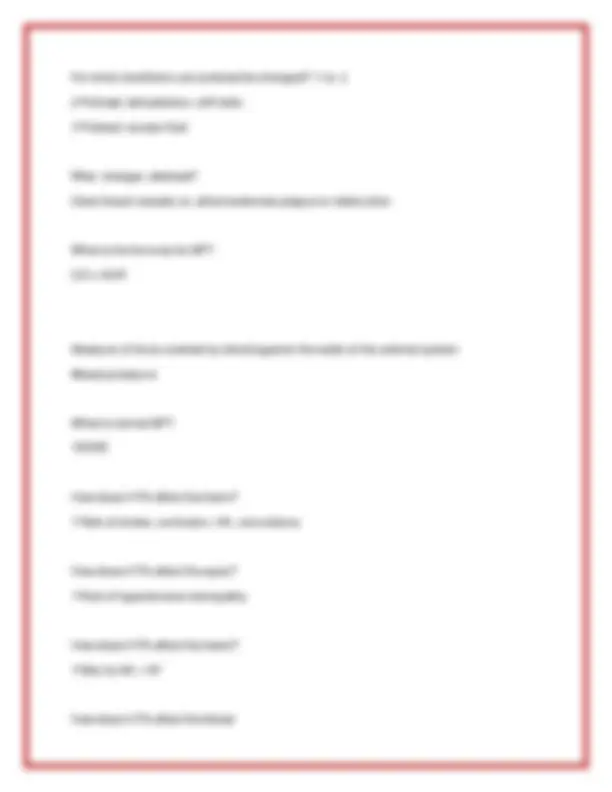
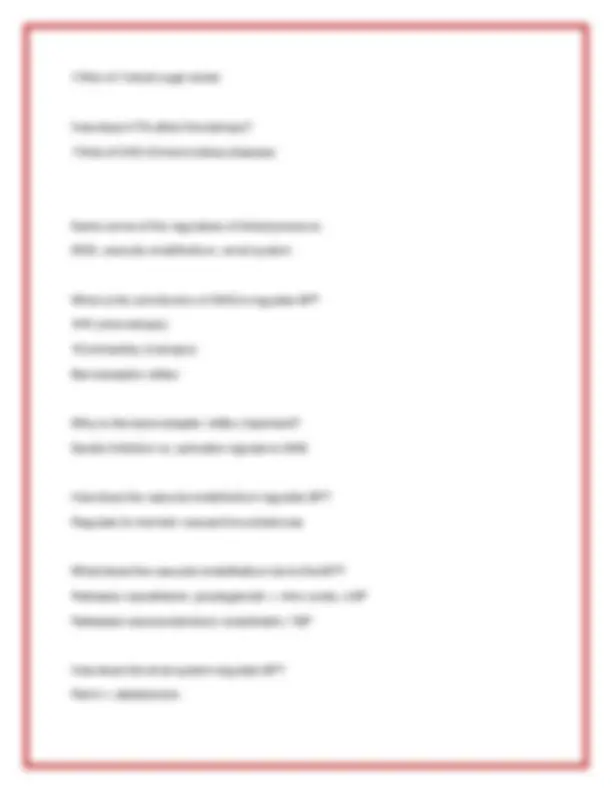
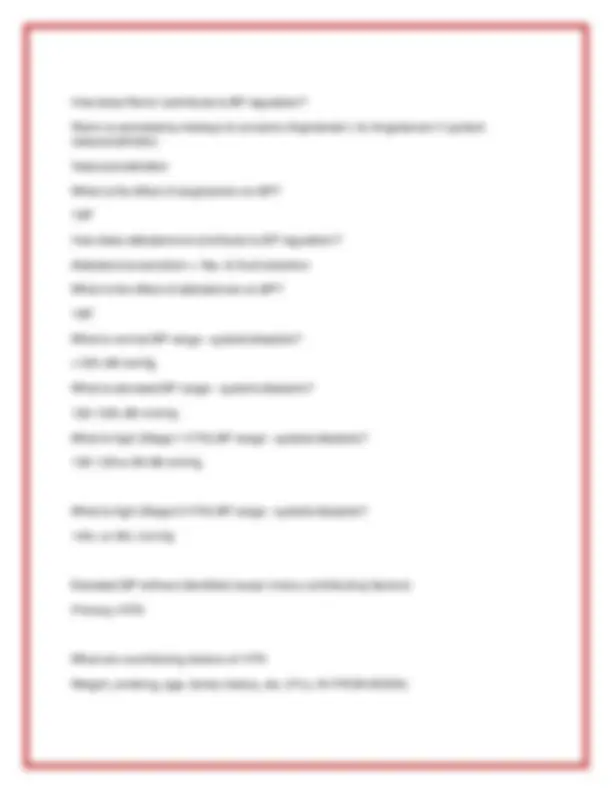
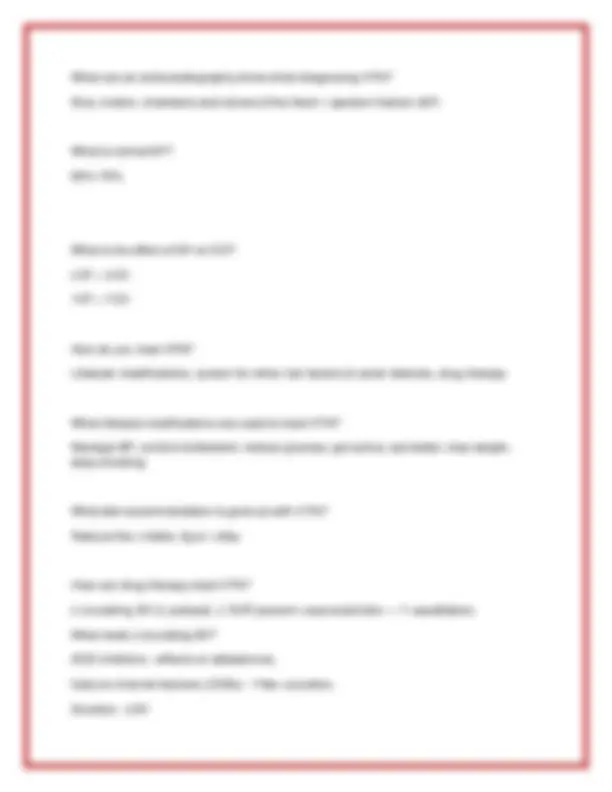
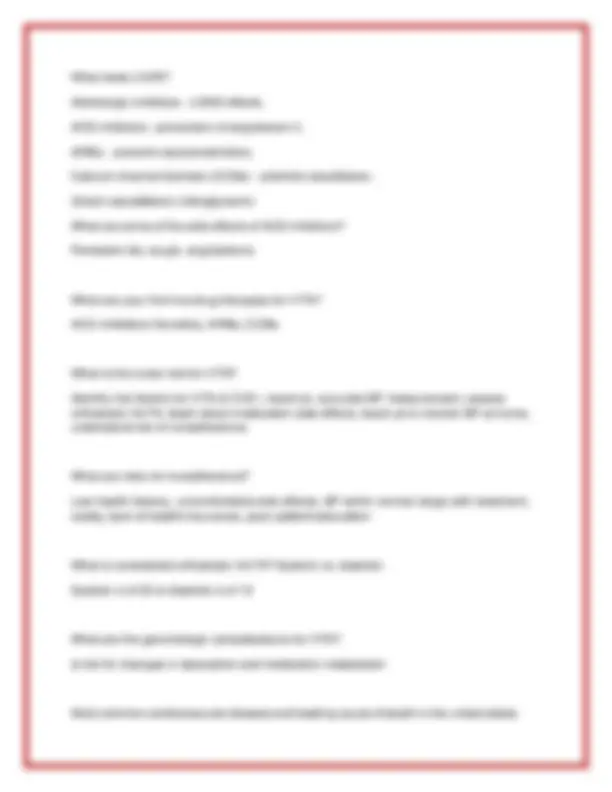
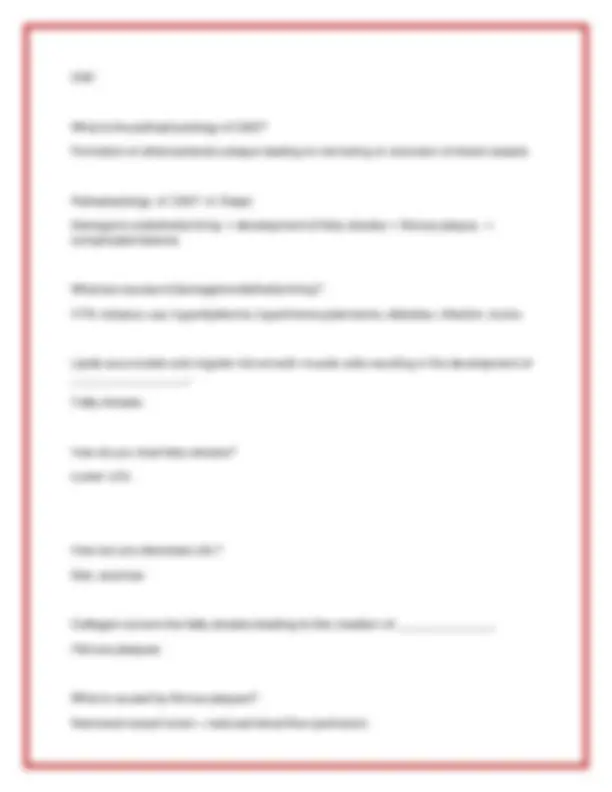
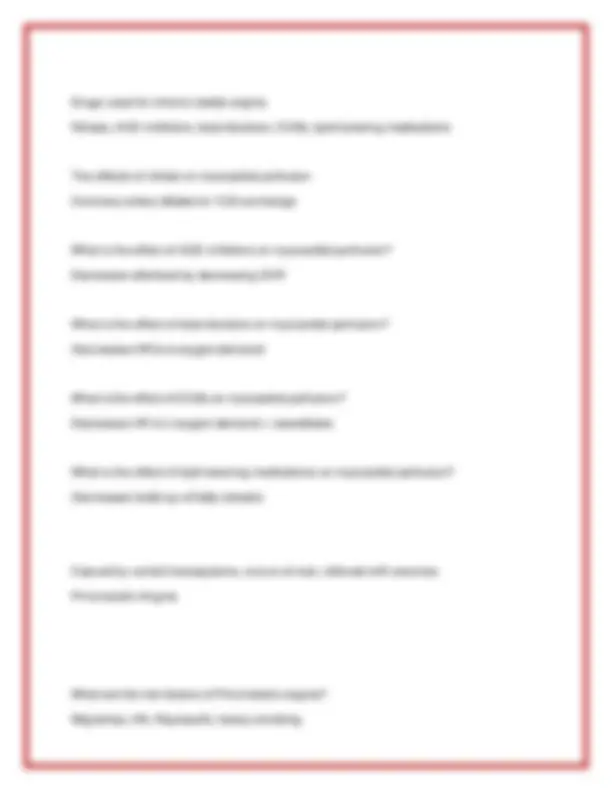
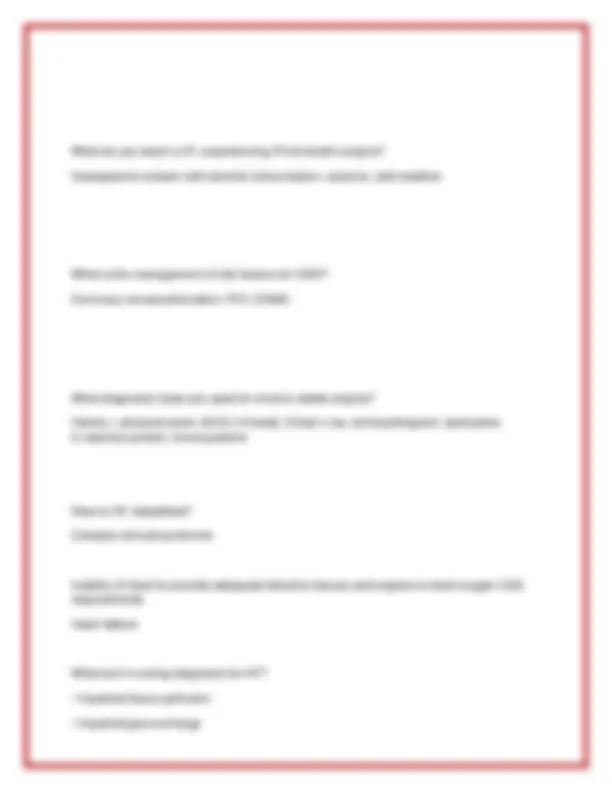
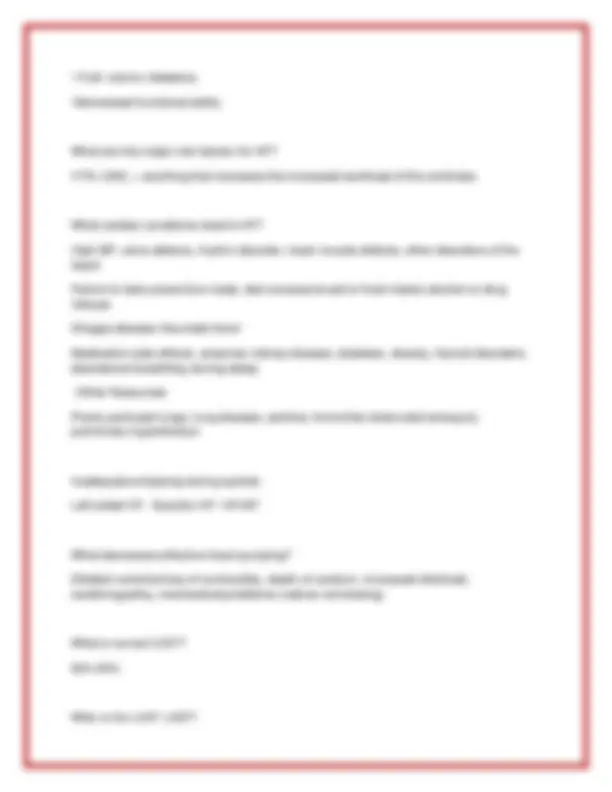
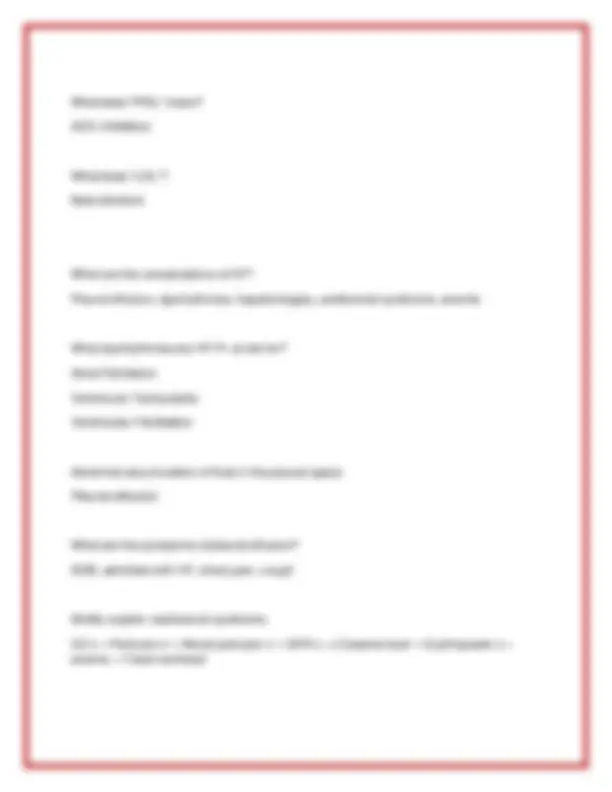
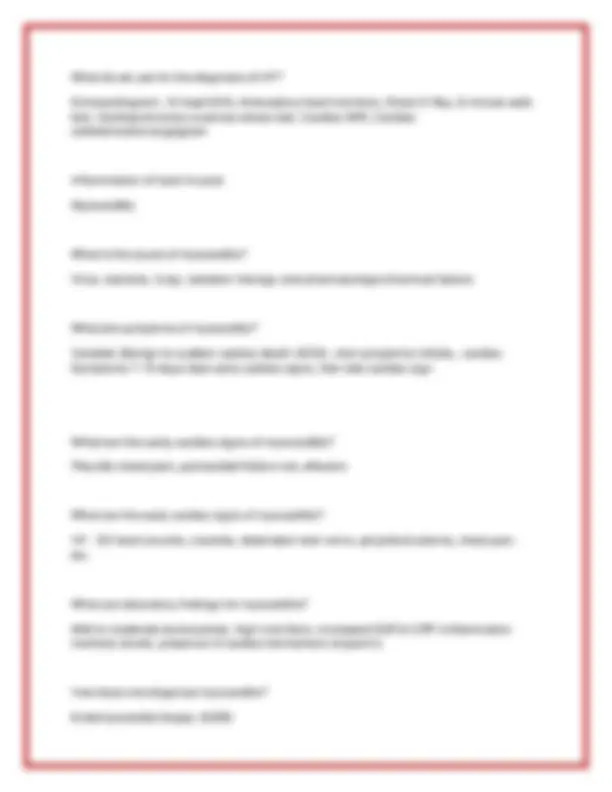
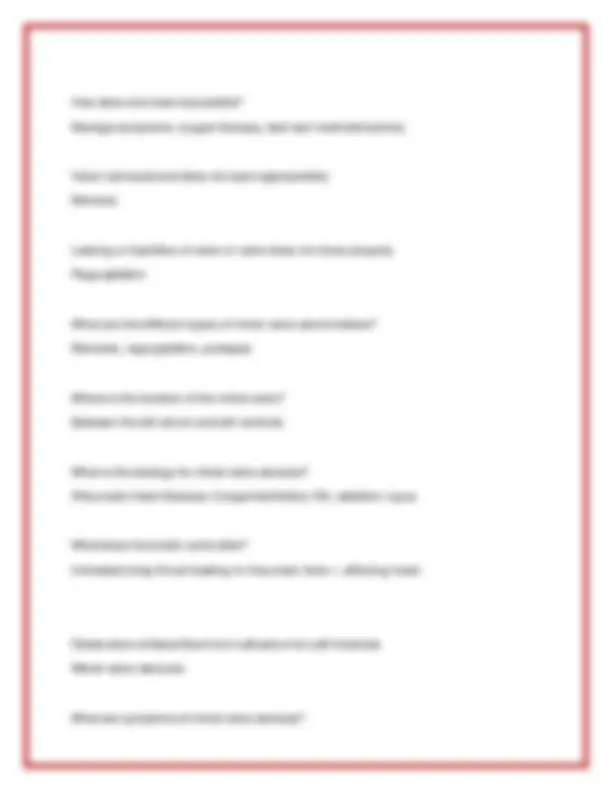
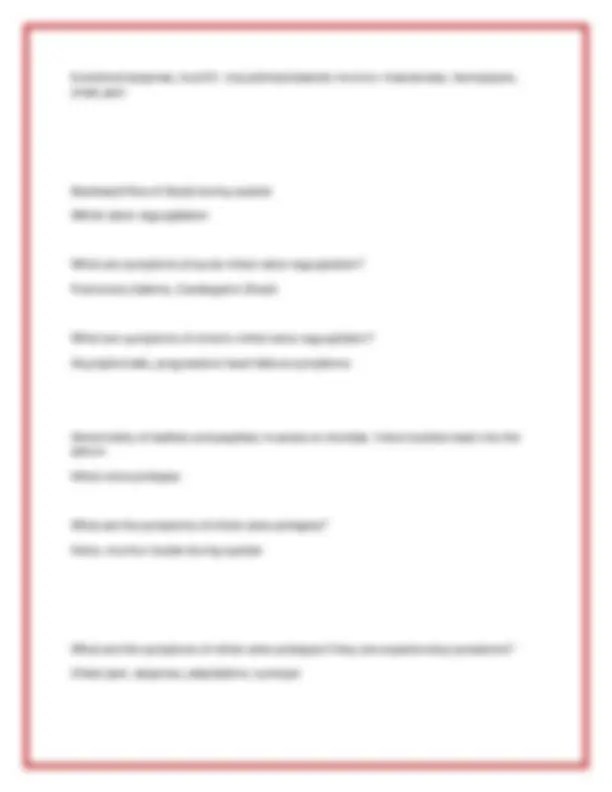
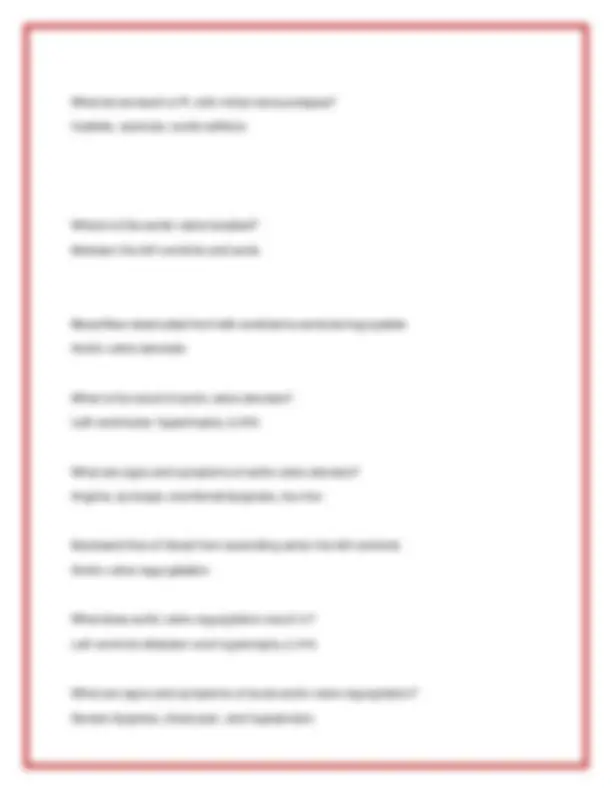
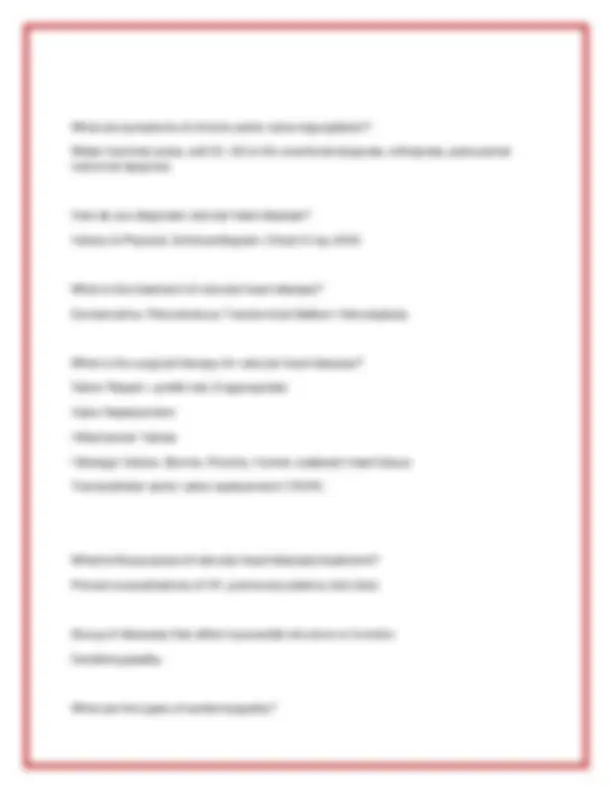
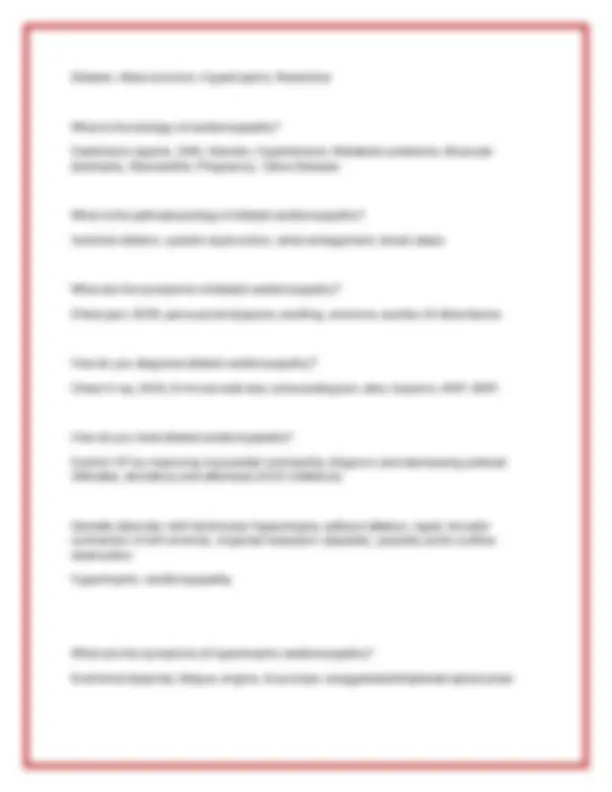
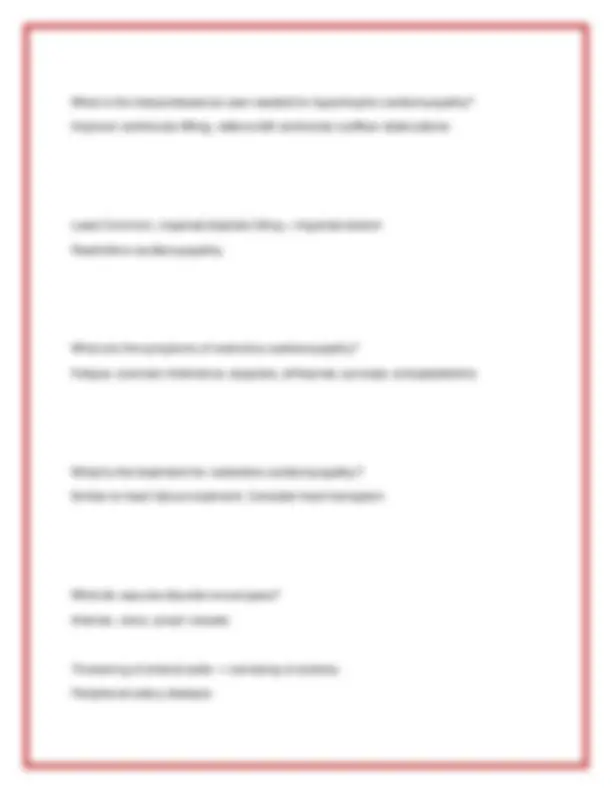
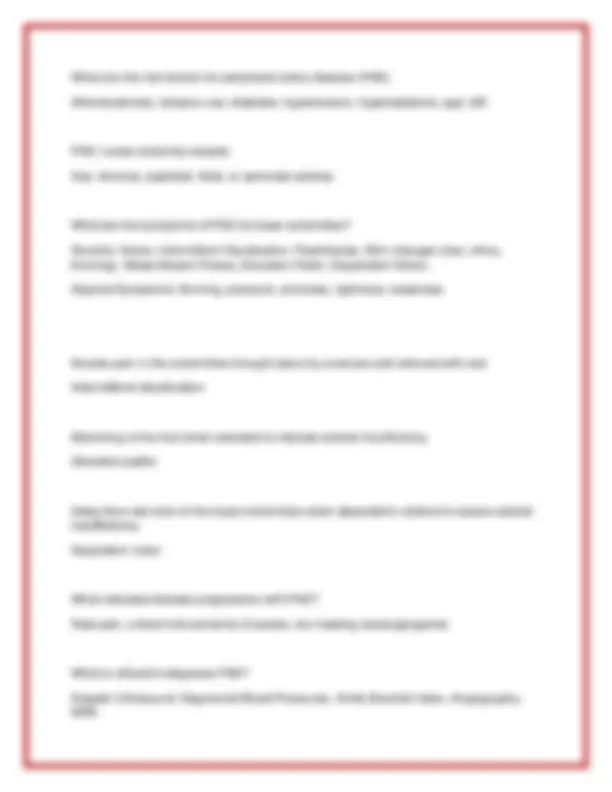
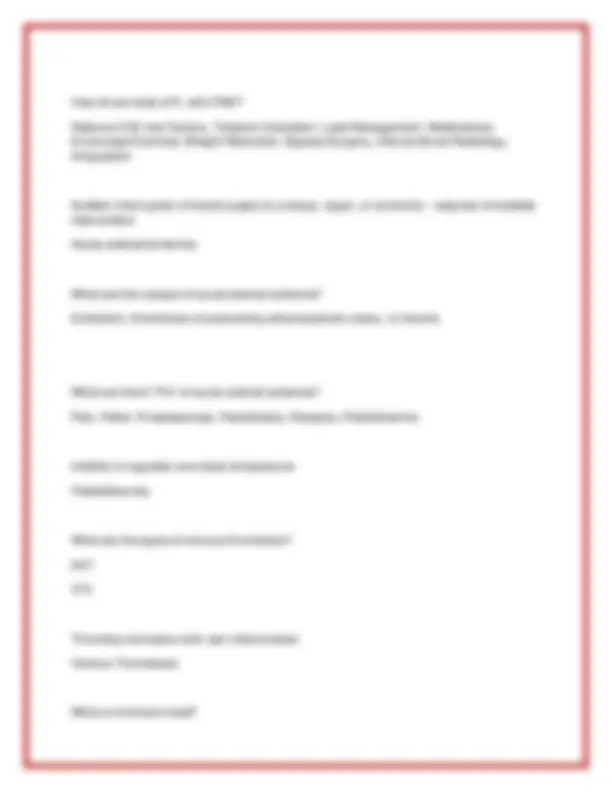
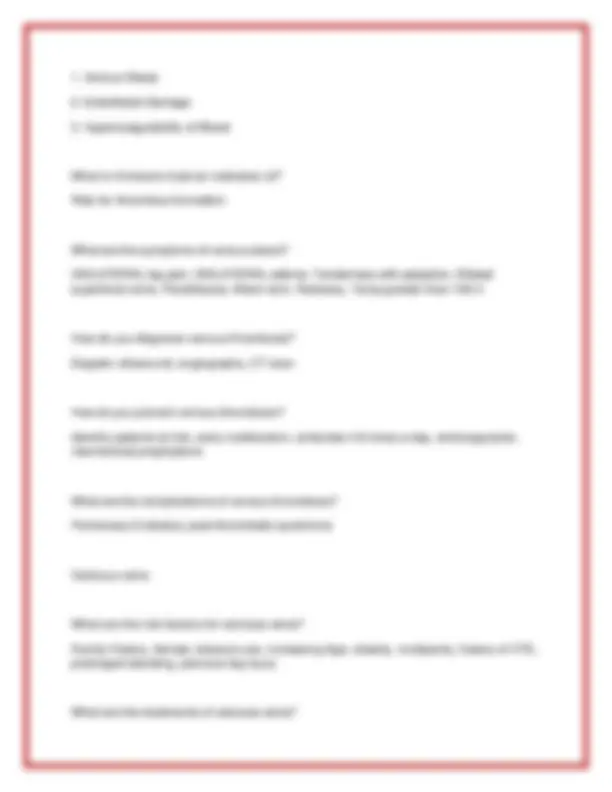
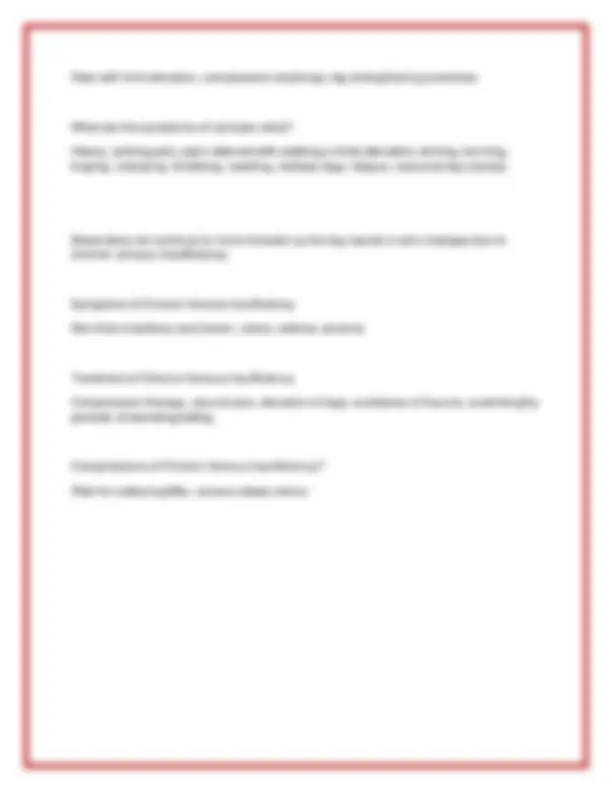


Study with the several resources on Docsity

Earn points by helping other students or get them with a premium plan


Prepare for your exams
Study with the several resources on Docsity

Earn points to download
Earn points by helping other students or get them with a premium plan
Community
Ask the community for help and clear up your study doubts
Discover the best universities in your country according to Docsity users
Free resources
Download our free guides on studying techniques, anxiety management strategies, and thesis advice from Docsity tutors
A series of questions and answers related to the structure, function, and regulation of the heart, focusing on key concepts in cardiovascular physiology. It covers topics such as blood flow through the heart, cardiac output, preload, afterload, blood pressure regulation, hypertension, and coronary artery disease. Suitable for students in nursing programs or related healthcare fields.
Typology: Exams
1 / 29

This page cannot be seen from the preview
Don't miss anything!






















Describe the hearts structure briefly : Four chambers with an inner lining, muscle layer and outer lining Inner lining of the heart Endocardium Muscle layer of the heart Myocardium Outer layer of the heart Epicardium What is the function of heart valves? Prevents backward blood flow How does blood flow through the heart (5 Steps)?
aorta and thus enters the systemic circulation. Volume of blood pumped by each ventricle in one minute Cardiac Output (CO) Cardiac Output formula CO = SV x HR Normal CO range at rest 4 - 8 L/min If HR 𝖳? CO 𝖳 If HR ↓? CO ↓ Signs of ↓ CO HoTN, cool, clammy, cyanotic or modeled skin, ↓ pulse, S/SX of altered mental status, etc. What changes SV? Preload, contractility, afterload Volume of blood stretching the ventricles at the end of diastole before contraction Preload The "strength" of the heart contraction Contractility Peripheral resistance Afterload
𝖳 Risk of 𝖳 blood sugar levels How does HTN affect the kidneys? 𝖳 Risk of CKD (Chronic kidney disease) Name some of the regulators of blood pressure. SNS, vascular endothelium, renal system What is the contribution of SNS to regulate BP? 𝖳HR (chronotropic) 𝖳Contractility (inotropic) Baroreceptor reflex Why is the baroreceptor reflex important? Sends inhibition vs. activation signals to SNS How does the vascular endothelium regulate BP? Regulate & maintain vasoactive substances What does the vascular endothelium do to the BP? Releases vasodilators: prostaglandin + nitric oxide, ↓ BP Releases vasoconstrictors: endothelin, 𝖳 BP How does the renal system regulate BP? Renin + aldosterone
How does Renin contribute to BP regulation? Renin is secreted by kidneys & converts Angiotensin I to Angiotensin II (potent vasoconstrictor) Vascoconstriction What is the effect of angiotensin on BP? 𝖳 BP How does aldosterone contribute to BP regulation? Aldosterone secretion = Na+ & fluid retention What is the effect of aldosterone on BP? 𝖳 BP What is normal BP range - systolic/diastolic? <120/<80 mmHg What is elevated BP range - systolic/diastolic? 120 - 129/<80 mmHg What is high (Stage 1 HTN) BP range - systolic/diastolic? 130 - 139 or 80 - 89 mmHg What is high (Stage 2 HTN) BP range - systolic/diastolic? 140> or 90> mmHg Elevated BP without identified cause (many contributing factors) Primary HTN What are contributing factors of HTN Weight, smoking, age, family history, etc. (FILL IN FROM BOOK)
Target organ damage of HTN - Hypertensive heart disease: CAD-damage to coronary artery endothelium LVH-thicker layer of the heart muscle HF Target organ damage of HTN- Disease of the cerebrovasculature: Cerebral atherosclerosis Stroke Target organ damage of HTN-Peripheral vascular disease: Aortic aneurysm Aortic dissection Target organ damage of HTN-Nephrosclerosis: CKD How do you diagnose HTN? BP log, laboratory studies What are the objectives for diagnosing HTN with laboratory studies? Identify + rule out causes of secondary HTN, evaluate target organ disease, evaluate cardiovascular risk, establish baseline vitals < initiating therapy What labs can be done to diagnose HTN? Urinalysis, BUN, Serum creatinine, Creatinine clearance, Electrolytes, Glucose, Lipid Panel, ECG/EKG, Echocardiography
What can an echocardiography show when diagnosing HTN? Size, motion, chambers and valves of the heart + ejection fraction (EF) What is normal EF? 55%-70% What is the affect of EF on CO? ↓ EF = ↓ CO 𝖳 EF = 𝖳 CO How do you treat HTN? Lifestyle modifications, screen for other risk factors & send referrals, drug therapy What lifestyle modifications are used to treat HTN? Manage BP, control cholesterol, reduce glucose, get active, eat better, lose weight, stop smoking What diet recommendation is given pt with HTN? Reduce Na+ intake, 2g or </day How can drug therapy treat HTN? ↓ circulating BV (↓ preload), ↓ SVR (prevent vasoconstriction + 𝖳 vasodilation) What meds ↓ circulating BV? ACE inhibitors - effects on aldosterone, Calcium channel blockers (CCBs) - 𝖳 Na+ excretion, Diuretics - ↓ BV
What is the pathophysiology of CAD? Formation of atherosclerotic plaque leading to narrowing or occlusion of blood vessels Pathophysiology of CAD? (4 Steps) Damage to endothelial lining → development of fatty streaks → fibrous plaque, → complicated lesions What are causes of damaged endothelial lining? HTN, tobacco use, hyperlipidemia, hyperhomocysteinemia, diabetes, infection, toxins Lipids accumulate and migrate into smooth muscle cells resulting in the development of . Fatty streaks How do you treat fatty streaks? Lower LDL How can you decrease LDL? Diet, exercise Collagen covers the fatty streaks leading to the creation of. Fibrous plaques What is caused by fibrous plaques? Narrowed vessel lumen = reduced blood flow (perfusion)
What can occur as a complication of fibrous plaques? Fissures Why is complicated lesions the most dangerous step of CAD pathophysiology? Plaques rupture → thrombus formation → narrowing or total occlusion of vessel What is the non-modifiable risk factors of CAD? Genetics, ethnicity, sex, age: Men > 45, Women > 55 What are the modifiable risk factors of CAD? LDL > 130, HDL < Total cholesterol > 200 Triglycerides > 150 Smoking, diabetes, high BP, lack of exercise, emotional stress, obesity What is a complication of CAD? Chronic stable angina What is the purpose of coronary arteries? Deliver nutrients and blood to the heart What occurs when oxygen demand > oxygen supply? Myocardial ischemia What are the characteristics of chronic stable angina?
Drugs used for chronic stable angina Nitraes, ACE inhibitors, beta blockers, CCBs, lipid lowering medications The effects of nitrate on myocardial perfusion Coronary artery dilates to 𝖳 O2 exchange What is the effect of ACE inhibitors on myocardial perfusion? Decreases afterload by decreasing SVR What is the effect of beta blockers on myocardial perfusion? Decreases HR to ↓ oxygen demand What is the effect of CCBs on myocardial perfusion? Decreases HR to ↓ oxygen demand + vasodilates What is the effect of lipid lowering medications on myocardial perfusion? Decreases build up of fatty streaks Casued by variant/vasospasms, occurs at rest, relieved with exercise Prinzmetal's Angina What are the risk factors of Prinzmetal's angina? Migraines, HA, Raynaud's, heavy smoking
What do you teach a Pt. expereincing Prinzmetal's angina? Vasospasms worsen with alcohol consumption, cocaine, cold weather What is the management of risk factors for CAD? Coronary revascularization: PCI, CABG What diagnostic tests are used for chronic stable angina? History + physical exam, ECG (12-lead), Chest x-ray, echocardiogram, lipid panel, C-reactive protein, homocysteine How is HF classified? Complex clinical syndrome Inability of heart to provide adequate blood to tissues and organs to meet oxygen (O2) requirements Heart failure What are 4 nursing diagnosis for HF?
What is the effect of dilation of left ventricle on CO? ↓ CO Inability of the ventricles to relax and fill during diastole Left-sided HF - Diastolic HF. HRpEF What is the problem in left-sided diastolic HF? Left Ventricle is stiff and noncompliant-no stretch Thickening of the left ventricle Left Ventricular Hypertrophy What does Left Ventricular Hypertrophy result in? Poor contractility, Higher O2 requirements, Poor Coronary artery circulation, Becomes ischemic easily, Prone to dysrhythmias
What are the cues of left-sided HF? Pulmonary congestion, paroxysmal nocturnal dyspnea, increased pulmonary capillary wedge pressure, restlessness, confusion, orthopnea, tachycardia, exertional dyspnea, fatigue, cyanosis What are the S/S pulmonary congestion? Cough, crackles, wheezes, bloody sputum, tachypnea What is the cause of right-sided HF (Co pulmonae)? Usually caused by left-sided heart failure, fluid backs up into venous system moves into tissues and organs What are the cues of right-sided HF? Fatigue, 𝖳 peripheral venous pressure, ascites, enlarged liver & spleen, distended jugular veins, anorexia & complaints of GI distress, weight gain, dependent edema What are the compensatory mechanisms of HF? RAAS activation, SNS activation, peptides & cytokines, ventricular adaptations, (dilation, hypertrophy, & remodeling) What are the counter-regulatory mechanisms of HF? Natriuretic peptide release: ANP (wall of atria), BNP (wall of ventricle) - 𝖳 GFR to excrete sodium + excess fluid, inhibits aldosterone release + dilates vessels, Nitric oxide & prostiglandins - vasodilate & decreases afterload/SVR What is compensated HF vs. decompensated HF? Compensated = Compensatory measures suceed in maintaining the body's oxygen requirements. Decompensated = Mechanisms can no longer maintain tissue perfusion
What do we use for the diagnosis of HF? Echocardiogram, 12 - lead EKG, Ambulatory heart monitors, Chest X-Ray, 6 - minute walk test, Cardiopulmonary exercise stress test, Cardiac MRI, Cardiac catheterization/angiogram Inflammation of heart muscle Myocarditis What is the cause of myocarditis? Virus, bacteria, fungi, radiation therapy and pharmacologic/chemical factors What are symptoms of myocarditis? Variable (Benign to sudden cardiac death (SCD), viral symptoms initially,, cardiac Symptoms 7 - 10 days later early cardiac signs, then late cardiac sign What are the early cardiac signs of myocarditis? Pleuritic chest pain, pericardial friction rub, effusion What are the early cardiac signs of myocarditis? HF - S3 heart sounds, crackles, distended neck veins, peripheral edema, chest pain, etc. What are laboratory findings for myocarditis? Mild to moderate leukocytosis, high viral titers, increased ESR & CRP (inflammation markers) levels, presence of cardiac biomarkers (troponin) How does one diagnose myocarditis? Endomyocardial biopsy (EMB)
How does one treat myocarditis? Manage symptoms, oxygen therapy, bed rest/ restricted activity Valve narrowed and does not open appropriately Stenosis Leaking or backflow of valve or valve does not close properly Regurgitation What are the different types of mitral valve abnormalities? Stenosis, regurgitation, prolapse Where is the location of the mitral valve? Between the left atrium and left ventricle What is the etiology for mitral valve stenosis? Rheumatic Heart Disease, Congenital Defect, RA, radiation, lupus What does rheumatic come after? Untreated strep throat leading to rheumatic fever + affecting heart. Obstruction of blood flow from Left atrium to Left Ventricle Mitral valve stenosis What are symptoms of mitral valve stenosis?